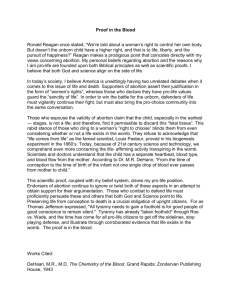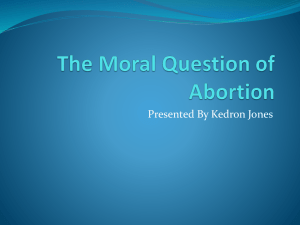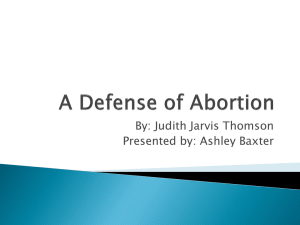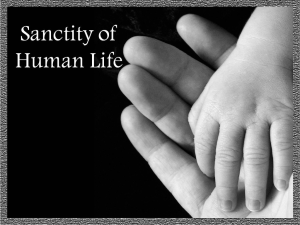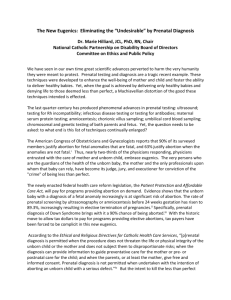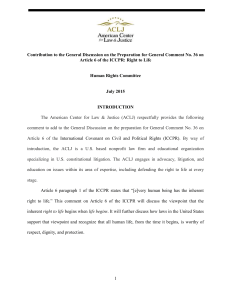ADF International - Office of the High Commissioner on Human Rights
advertisement
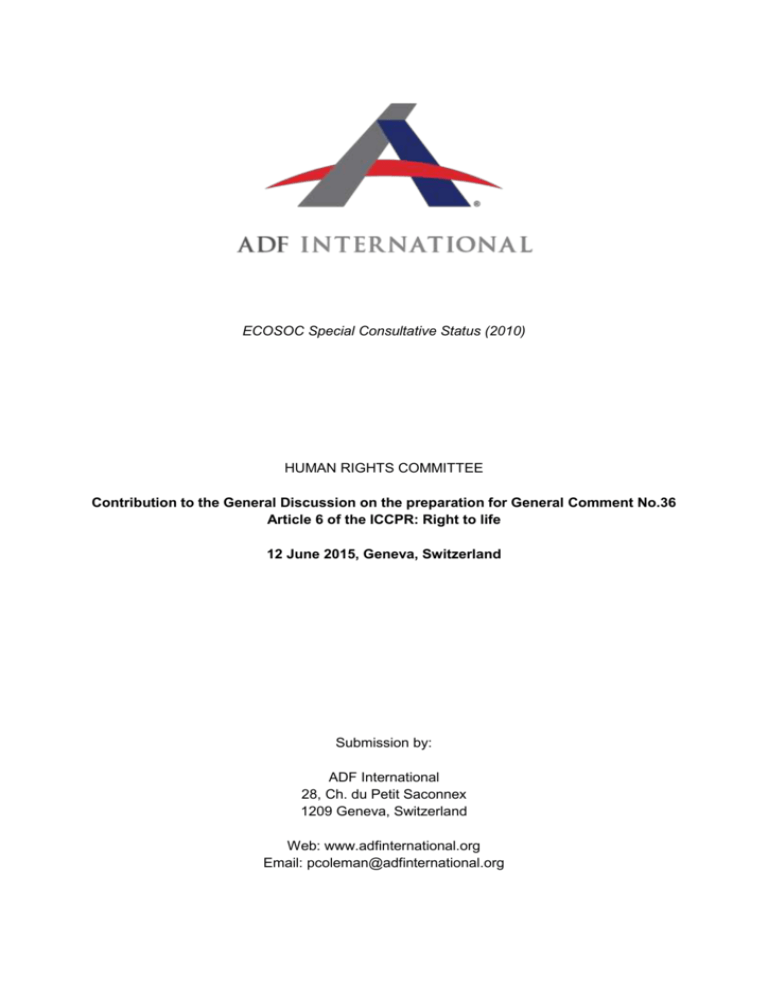
ECOSOC Special Consultative Status (2010) HUMAN RIGHTS COMMITTEE Contribution to the General Discussion on the preparation for General Comment No.36 Article 6 of the ICCPR: Right to life 12 June 2015, Geneva, Switzerland Submission by: ADF International 28, Ch. du Petit Saconnex 1209 Geneva, Switzerland Web: www.adfinternational.org Email: pcoleman@adfinternational.org Introduction 1. ADF International is a global alliance-building legal organization that advocates for religious freedom, life, and marriage and family before national and international institutions. As well as having ECOSOC consultative status with the United Nations (registered name “Alliance Defending Freedom”), ADF International has accreditation with the European Commission and Parliament, the Fundamental Rights Agency of the European Union, the Organization for Security and Cooperation in Europe, and Organization of American States. 2. This submission covers the applicability of Article 6 to the unborn and other forms of human existence. It first details the legal justifications for the right to life of the unborn, considering the International Covenant on Civil and Political Rights (ICCPR), other international human rights instruments, and national legal provisions. Secondly, it defines the unborn as all human life from fertilization, the earliest stage of human development, and explains how human embryos in vitro are included in the definition of unborn and therefore deserve protection. Thirdly, it indicates how the recognition of the unborn in international law means that there cannot be an implicit right to abortion in the ICCPR. Lastly, this submission uses both UN treaties and decisions of the European Court of Human Rights to show that the right to life does not justify a right to die. 3. Accordingly, ADF International makes the following recommendations to the Human Rights Committee in its discussion of ICCPR Article 6: (a) Affirm that the right to life applies to the unborn, from the moment of fertilization, including to human embryos in vitro; (b) Affirm that given the recognition of the unborn in the ICCPR and other international treaties and national laws, no human “right to abortion” exists; and (c) Affirm that the right to life does not justify and is fundamentally incompatible with a “right to die”. I. “Applicability of Article 6 to the Unborn and other Forms of Human Existence”1 A. Legal Justifications for the Right to Life of the Unborn i. Right to Life of the Unborn in ICCPR Article 6 4. Article 6 (1) of the ICCPR states, “Every human being has the inherent right to life.” In prior general comments on Article 6, the Committee has stated clearly that the right to life should be interpreted broadly. Specifically, the Committee has noted, “[T]he right to life has been too often narrowly interpreted. The expression ‘inherent 1 Wording taken from the draft note prepared by Yuval Shany and Nigel Rodley, Rapporteurs, p.2 (CCPR/C/GC/R.36). Available at http://www.ohchr.org/EN/HRBodies/CCPR/Pages/GC36-Article6Righttolife.aspx. 1 right to life’ cannot properly be understood in a restrictive manner[.]”2 Therefore, consistent with its foundational importance to all other rights, the meaning of Article 6 must be construed broadly, erring on the side of protecting more groups and more instances, rather than fewer. 5. Moreover, the ICCPR’s prohibition of the death penalty for pregnant women implicitly recognizes the right to life of the unborn. Although the ICCPR allows for the death penalty to be imposed on both adult men and women, it explicitly prohibits applying the death penalty to pregnant women. Article 6(5) states, “Sentence of death shall not be imposed for crimes committed by persons below eighteen years of age and shall not be carried out on pregnant women.” Under the ICCPR, all other adult women may be subject to the death penalty, therefore this clause must be understood as recognizing the unborn’s distinct identity from the mother and protecting the unborn’s right to life. 6. As the travaux préparatoires3 of the ICCPR state, “The principal reason for providing in paragraph 4 [now Article 6(5)] of the original text that the death sentence should not be carried out on pregnant women was to save the life of an innocent unborn child.”4 Similarly, the Secretary General report of 1955 notes that the intention of the paragraph “was inspired by humanitarian considerations and by consideration for the interests of the unborn child[.]”5 ii. Recognition of the Unborn in International Instruments International human rights instruments 7. The clear reference to the unborn child in the ICCPR is buttressed by several other references to the unborn in international documents. For example, the Geneva Convention relative to the Protection of Civilian Persons in Time of War states that “the wounded and sick, as well as the infirm, and expectant mothers, shall be the object of particular protection and respect.”6 Similarly, the Convention on the Prevention and Punishment of the Crime of Genocide defines genocide to include “imposing measures intended to prevent births within the group.”7 8. The protection of unborn life is also found through an ordinary reading of the language in the preamble of the Convention on the Rights of the Child (CRC). According to the Vienna Convention, the preamble of a treaty provides necessary interpretive context.8 It is therefore striking that the CRC explicitly recognizes the 2 Adopted 30 April 1982, HRI/GEN/1/Rev.9 (Vol. I). In accordance with the Article 32 of the Vienna Convention, the travaux préparatoires are considered to be a “supplementary means of interpretation.” 4 A/3764 § 18. Report of the Third Committee to the 12th Session of the General Assembly, 5 December 1957. 5 A/2929, Chapter VI, §10. Report of the Secretary-General to the 10th Session of the General Assembly, 1 July 1955. 6 Article 16. Emphasis added. 7 Article 2(d). Emphasis added. In 1948 during the Nuremberg Trials, the practice of encouraging abortions among Eastern Europeans was considered a crime against humanity. See United States v. Greifelt, US Military Tribunal Nuremberg, Judgment of 10 March 1948, §§ 102–108. 8 Article 31(2) states, “The context [ . . . ] shall comprise [ . . . ] the text, including its preamble and annexes.” 3 2 child before birth as a rights-bearing person entitled to special need and protection. The preamble states, “[T]he child, by reason of his physical and mental immaturity, needs special safeguards and care, including appropriate legal protection, before as well as after birth.”9 This clear reference to the unborn child was included directly from the Declaration of the Rights of the Child. The Declaration was adopted unanimously by the then-78 Member States of the UN General Assembly in Resolution 1386 (XIV), 20 November 1959. 9. Article 1 of the CRC defines a child as “every human being below the age of eighteen years.” This provides an upper limit as to who is a child, but does not provide a lower limit on when the status of “child” attaches. Moreover, Article 6 of the CRC holds, “States Parties recognize that every child has the inherent right to life. States Parties shall ensure to the maximum extent possible the survival and development of the child.” Viewed in the context of the preamble, both Articles 1 and 6 of the CRC indicate recognition of, and protection for, unborn life. European Convention on Human Rights 10. Article 2(1) of the European Convention on Human Rights (ECHR) states, “Everyone’s right to life shall be protected by law.” 11. The European Court of Human Rights’ (ECtHR) most stringent treatment of what protections should be afforded to the unborn child under the ECHR can be found in the case of Vo v. France,10 in which it acknowledged that with scientific progress a growing consensus is emerging among Member States that the unborn child is part of the human race and is worthy of some level of protection.11 12. The ECtHR has never defined Article 2 so as to exclude the protection of foetal life from its scope.12 Furthermore, the permissible exceptions to Article 2, set out in paragraph 2, provide an exhaustive list in which deprivation of life can be justified where the use of force used will be no more than absolutely necessary: (a) in defence of any person from unlawful violence; (b) in order to effect a lawful arrest or to prevent the escape of a person lawfully detained; (c) in action lawfully taken for the purpose of quelling a riot or insurrection. The ECtHR itself has never departed from this view except with regard to the margin of appreciation afforded to Member States where abortion is viewed as a derogation from the right to life within the meaning of their national legislation. The ECtHR has also called for restraint with a view to unborn life within the context of bioethics,13 which is also reflected in the Council of Europe’s 1997 Convention on Human Rights and Biomedicine (the Oviedo Convention)14 and the conservative jurisprudence of the Court of Justice of the European Union in this area.15 9 Emphasis added. Application No. 53924/00, 8 July 2004. 11 Case of Vo v. France, op cit., at para. 84. 12 Cf. Vo v. France, op. cit., separate opinion of Judge Costa at para. 11. 13 See e.g.: S. H. and others v. Austria, [GC], no. 57813/02, 3 November 2011. 14 See Article 1 protecting human “dignity” and Article 3 on bioethics. 15 Oliver Brüstle v. Greenpeace eV. C-34/10 (18 October 2011). 10 3 13. Furthermore, the ECtHR has respected and recognized the profound moral values associated with the right to life of the unborn child in relation to Article 2 of the ECHR.16 It has therefore ruled, for example, that Article 8 on the right to respect for private and family life cannot be interpreted as conferring a right to abortion.17 It has also recognized, because of the application of Article 2, that States are required to make regulations compelling hospitals to take measures to protect the life (born or unborn) of their patients.18 14. In summary, while the jurisprudence of the ECtHR has been purposeful in not answering the question of when life begins, it has been equally clear in recognizing that the unborn child is worthy of protection under the ECHR. American Convention on Human Rights 15. The most explicit reference to the unborn within international human rights instruments is contained in Article 4(1) of the American Convention on Human Rights (ACHR), which states, “Every person has the right to have his life respected. This right shall be protected by law and, in general, from the moment of conception. No one shall be arbitrarily deprived of his life.”19 While the wording of Article 4(1) appears to allow exceptions to the legal protection of the right to life of the unborn, it does not explicitly describe them. Thus, the correct interpretation of Article 4(1) has been the source of much debate.20 Clearly, however, protecting the right to life from the moment of conception is the purpose and intention of the article read as a whole. 16. Therefore, given the above references within international and regional human rights treaties, there is strong support for the proposition that the international legal framework can be understood as recognizing unborn life. iii. Recognition of the Right to Life of the Unborn in National Legal Provisions of Numerous ICCPR Signatories 17. In addition to the ICCPR and other international instruments, numerous signatories to the ICCPR recognize the right to life of the unborn in their constitutions and legal provisions. Article 6 may be interpreted to include the right to life of the unborn in accordance with these provisions. 18. Numerous constitutions include explicit protections for unborn life. The constitutions of the following signatories to the ICCPR provide examples: Ireland (Article 40.3.3°); Hungary (Article 2); Guatemala (Article 3); Slovakia (Article 15(1)); Dominican Republic (Article 37); Ecuador (Article 45); El Salvador (Title 1, Article 1); Chile (Article 19(1)); Honduras (Article 67); Peru (Article 2(1)); Madagascar (Title 1, Article 19); and the Philippines (Article 1, section 12). Additionally, the constitutions of 16 A., B. and C. v. Ireland, [GC], no. 25579/05, 16 December 2010, at paras. 222-223. Id., at para. 214. 18 See e.g.: Powell v. the United Kingdom (dec.), no. 45305/99, ECHR 2000-V. 19 Emphasis added. 20 For a discussion of the various interpretations of Article 4(1), see the amici curiae brief of ADF, CFAM, and AUL in the case of Gretel Artavia Murillo et al v. Costa Rica, Case No. 12,361 (2012), available at http://adfinternational.org/2012/11/28/murillo-v-costa-rica/. 17 4 Colombia, Costa Rica, and Nicaragua all state that “the right to life is inviolable,” and this is interpreted as being extended to the unborn.21 19. Furthermore, legislative provisions of signatories around the world recognize the right to life of the unborn. Examples in Latin America include Mexico, where a large number of state constitutions explicitly protect unborn life, from either the moment of conception or the moment of fertilization. Article 5 of the Constitution of the Mexican State of Chihuahua, for instance, holds, “All human beings have the right to legal protection of their life, from the moment of conception.”22 Similarly, in Argentina, the majority of the Provincial Constitutions protect unborn life. For example, Article 12(1) of the Buenos Aires Provincial Constitution states that every person in the Province enjoys the right to life, “from the time of conception until natural death.”23 20. In Europe, the Basic Law of Germany obliges the State to protect human life, including that of the unborn. This duty is grounded in Article 1(1), concerning “inviolable” human dignity, and Article 2(2), which attributes the “right to life and physical integrity” to “every person.”24 The German Constitutional Court has confirmed that the word “everyone” extends to (living) unborn human beings.25 In Latvia, the Medical Treatment Law provides, “A doctor has a duty to protect unborn life[.]” Legislation in Poland states that “every human being shall have an inherent right to life from the moment of conception”26 and that life shall be protected “including in the prenatal phase.” 21. The laws of the United States also recognize that the unborn deserve protection and have their own legal rights. For example, the federal Unborn Victims of Violence Act recognizes an unborn child as a legal victim when it is killed or injured during a federal crime of violence, with rights distinct from those of the mother. The law defines “unborn child” as a “child in utero,” which in turn is “a member of the species Homo sapiens, at any stage of development, who is carried in the womb.” 27 Further, at least 38 of the 50 U.S. states have foetal homicide laws. 28 22. These national legal provisions, in addition to the international instruments listed above, are compatible with the growing international consensus in favour of broad protection for human life throughout its stages of development. 21 See, for example, paragraph 34 of the response of the government of Costa Rica in the InterAmerican Court of Human Rights case Artavia Murillo v. Costa Rica, in which the government explains that the destruction of embryos is in violation of its constitution. Available at https://www.cidh.oas.org/demandas/12.361Esp.pdf. 22 The Mexican State Constitutions that contain protections for unborn life are: Baja California, Chihuahua, Coahuila, Colima, Durango, Guanajuato, Jalisco, Morelos, Nayarit, Oaxaca, Puebla, Queretaro, Quintana Roo, San Luis Potosi, Sonora, and Yucatan. 23 The Argentinean Provincial Constitutions that contain protections for unborn life are: Buenos Aires, Catamarca, Chaco, Chubut, Cordoba, Corrientes Formosa, Rio Negro, Salta, San Juan, San Luis, Santiago de Estero, Tierra del Fuego, and Tucumán. 24 Basic law, article 2(2). 25 39 BVerfGE 1 (1975). 26 Law on Family Planning (Protection of the Human Foetus and Conditions permitting Pregnancy Termination) 1993, s.1. 27 18 U.S.C. § 1841. 28 National Conference of State Legislatures, Fetal Homicide Laws, available at http://www.ncsl.org/research/health/fetal-homicide-state-laws.aspx. 5 B. Definition of the Unborn and Applicability of the Right to Life to Human Embryos Definition of Unborn 23. Given the references to the pregnant woman in the ICCPR and the unborn in the CRC, the right to life, including that guaranteed in Article 6 of the ICCPR, can and should be applied to the human life being carried by the pregnant woman. The right to life should attach as soon as the life is created, that is, at the moment of fertilization. 24. This is supported by the language of the CRC preamble, which purposefully does not establish a beginning point at which a child needs protection, suggesting that the unborn child is human life at any point before birth. 25. The U.S. Unborn Victims of Violence Act is instructive. It gives legal rights to the “unborn child,” defined as “a member of the species Homo sapiens, at any stage of development, who is carried in the womb.” This includes the zygote, blastocyst, embryo, and foetus. Applicability to human embryos 26. Human embryos in vitro, despite their location outside the womb, also deserve protection. The ruling of the only international court ever to define directly when life begins, in a case involving the destruction of human embryos, is persuasive. 27. In 2011, the Court of Justice of the European Union (CJEU), in Oliver Brüstle v. Greenpeace e.V., a case on the patentability of a process that involved the destruction of human embryos, answered the question of what is meant by the term “human embryo.”29 28. The CJEU noted that the European Union legislature had intended to exclude any possibility of patentability where respect for “human dignity” could be affected. Thus, the concept of the human embryo must be understood in a wide sense.30 Accordingly, the CJEU held that any human ovum must, as soon as fertilized, be regarded as a human embryo, since fertilization commences the process of development of a human being. Moreover, the CJEU held that the same classification must apply to a non-fertilized human ovum into which the cell nucleus from a mature human cell, has been transplanted, and a non-fertilized human ovum whose division and further development have been stimulated by parthenogenesis.31 Regarding stem cells obtained from a human embryo at the blastocyst stage, the CJEU held that it is for the referring court to ascertain, in the light of scientific developments, whether they are capable of “commencing the process of 29 Case C-34/10, 18 October 2011. Available at http://curia.europa.eu/jurisp/cgibin/form.pl?lang=EN &Submit=rechercher&numaff=C-34/10. 30 § 34. 31 The Court noted that “although those organisms have not, strictly speaking, been the object of fertilisation, due to the effect of the technique used to obtain them they are, as is apparent from the written observations presented to the Court, capable of commencing the process of development of a human being just as an embryo created by fertilisation of an ovum can do so.” § 36. 6 development of a human being” and therefore are included within the concept of the human embryo.32 Thus, the CJEU—perhaps mindful of the fact that at present, stem cells obtained from a blastocyst are pluripotent and are incapable of developing into a human being—avoided stating that pluripotent cells are not regarded as human embryos. Instead, the CJEU stated that if cells can commence the process of development into a human being, they must be protected within the concept of the human embryo. 29. Precisely stated, the Grand Chamber of the CJEU ruled that in the context of European patent law, life begins from the moment of fertilization. It further held that fertilization marks the commencement of the process of development of the human being. 30. The CJEU held that the definition of the human embryo must be understood in a wide sense, and went on to provide legal protection for that embryo. The ruling lends support to the propositions that: (i) human life begins at fertilization; (ii) the human embryo is worthy of protection; and (iii) the argument that the embryo is “not yet human” in certain stages of development is no longer valid. 31. The Oviedo Convention on Human Rights and Biomedicine also recognizes the inherent value of the human embryo. Article 18 prohibits the creation of human embryos for research purposes and calls for the “adequate protection” of human embryos in vitro used for research. This is in recognition that the human embryo is a “human being [whose interests and welfare] shall prevail over the sole interest of society or science.” 32. Therefore, in the development of law for the scientific community there is an everincreasing and robust protection of the unborn child from fertilization. C. No Implicit “Right to Abortion” in ICCPR Article 6 33. International law recognizes the right to life of the unborn. By contrast, neither the ICCPR nor any other international human rights treaty recognizes a right to abortion. Yet abortion advocates claim that the right to abortion is implicit in international law because certain rights of the mother require abortion legalization, including the woman’s own right to life. However, as detailed below, the right to life in Article 6 does not create or justify a so-called “right to abortion” in international law, and in fact such a right to abortion would put more women at risk. 34. First, an ordinary reading of the text of the ICCPR does not find a right to abortion. There is no mention of abortion. Further, the recognition of the unborn in the ICCPR and other international human rights instruments is incompatible with a right to abortion. The right to life of the unborn, implicitly recognized in Article 6, means that Article 6 or any other provision of the ICCPR cannot be understood as providing a categorical right to take the life of the unborn. 35. Nevertheless, abortion proponents argue that Article 6 itself provides justification for a so-called right to abortion within the ICCPR. The argument is that abortion must be 32 § 37. 7 available in the case of a life-threatening pregnancy, or the woman’s right to life is violated. 36. In most cases it is impossible to say with certainty that a pregnancy will result in the death of a woman. It is also impossible to say with certainty that an abortion would save the woman’s life. Creating a right based on uncertainty is imprudent, especially when it is certain that abortion will take the life of the unborn. Instead, a doctor can treat the pregnant woman while also taking care to preserve the life of the unborn, with the understanding that the life of the unborn may perish in the course of treatment. In this case, the goal is never to take the life of the unborn, unlike with abortion. 37. What “life-threatening” means or may evolve to mean is also concerning. Given that “health” exceptions to abortion prohibitions are broadly construed, often including nebulous concepts such as emotional health, it is possible that a “life” exception would eventually be so broad as to cover almost any situation. In this case, the right to life of the unborn is completely eroded. 38. On a broader community-wide level, recognizing abortion as a human right and requiring abortion legalization are not solutions to maternal mortality and do nothing to guarantee a woman’s right to life. 39. First, legalizing abortion does not guarantee that it becomes safe. A report by the Guttmacher Institute states, “Changing the law [ . . . ] is no guarantee that unsafe abortion will cease to exist.”33 Legalizing abortion normalizes it, making abortions more common. Recognizing a right to abortion will not meet the needs of pregnant women in countries where the maternal mortality ratio is high, because women die during pregnancy and childbirth most commonly from sepsis and hemorrhage, which are also two of the main causes of abortion-related deaths. The health care system infrastructure is already poor in these countries, and more abortions may well mean more maternal deaths. 40. Further, the most recent evidence controverts the idea that a total prohibition on abortion undermines maternal health. A major study published in the British Medical Journal this year concludes that States with “less permissive” abortion laws “exhibited consistently lower maternal mortality rates.”34 Although the study explains these differences in terms of other independent factors rather than in terms of abortion legislation itself, it nevertheless concludes, “No statistically independent effect was observed for abortion legislation, constitutional amendment or other covariates.”35 Because abortion legislation has no effect on maternal mortality, abortion need not be legalized to protect women’s health. 33 See Susan A. Cohen, Facts and Consequences: Legality, Incidence and Safety of Abortion Worldwide, GUTTMACHER POL’Y REV. (2009), available at http://www.guttmacher.org/pubs/gpr/12/4/ gpr120402.html. 34 Elard Koch, Monique Chireau, and Fernando Pliego et. al., Abortion Legislation, Maternal Healthcare, Fertility, Female Literacy, Sanitation, Violence Against Women and Maternal Deaths: A Natural Experiment in 32 Mexican States, BMJ OPEN 2015:5 e006013, doi:10.1136/bmjopen-2014006013, p. 1. 35 Id. 8 41. Case studies of three nations—Ireland, Malta, and Chile—are particularly relevant on the point. 42. According to the World Health Organization, Ireland is one of the safest places in the world for an expectant mother to give birth. After banning almost all abortions in 1983, the country strengthened its focus on providing high-quality prenatal care and rose to become an international model in women’s health. UNICEF ranked the country number 1 in 2005 and number 3 in 2008 for the lowest global maternal mortality rate. Richly documented evidence reveals that, in an emergency, Irish doctors will go to virtually any length to save the lives of both mother and baby, and have succeeding in doing so—thus demonstrating that it is possible to protect them both. 43. Similarly, following the total prohibition of abortion in 1989, Chile experienced a steep decline in the number of maternal deaths (69.2 percent).36 Chile came to have the second-lowest maternal mortality ratio in the Western Hemisphere (after Canada). 44. An unprecedented fifty-year analysis of maternity data from Chile reveals two essential facts. First, restricting access to abortion services does not negatively impact maternal mortality. In fact, prohibiting abortion in Chile resulted in significantly improved maternal health for the country by freeing up resources to care for mothers and babies. Second, the data make clear that women’s educational levels are the single most important factor in reducing mortality rates among mothers. The more educated a woman is, the greater her ability to access the health care resources available to her and thus go safely through pregnancy and childbirth. 45. Malta, with one of the lowest maternal mortality rates in the world, is another one of the safest places to be pregnant. Abortion is illegal in Malta. Yet Malta boasts a maternal mortality ratio of 8, which is equal to or lower than that of 18 countries that allow abortion on demand and is exactly the same as Belgium, France and Switzerland. 46. To improve maternal health and decrease the risks women have of dying during pregnancy or childbirth, the focus must be on providing the key interventions necessary to get mother and baby safely through pregnancy and childbirth, not providing abortion. Almost all maternal deaths are preventable,37 particularly when skilled birth attendants are present to manage complications and the necessary drugs are available, such as oxytocin (to prevent hemorrhage) and magnesium sulfate (to treat pre-eclampsia). Focusing on abortion legalization and liberalization of abortion laws takes money, manpower, and other resources away from these lifesaving maternal health interventions. Koch et al., Women’s Education Level, Maternal Health Facilities, Abortion Legislation and Maternal Deaths: A Natural Experiment in Chile from 1957 to 2007, PLOS ONE (2012), available at http://journals.plos.org/plosone/article?id=10.1371/journal.pone.0036613. 37 World Health Organization, Fact Sheet, Maternal mortality, available at http://www.who.int/mediacentre/factsheets/fs348/en/. 36 9 D. Conclusion 47. The ICCPR implicitly recognizes the right to life of the unborn, which is reinforced by the recognition of the unborn in other international human rights treaties and national legal provisions. While abortion proponents claim that international human rights treaties, including the ICCPR, contain a right to abortion, there is no justification for this position within the ordinary meaning of the text, and the idea that a woman’s right to life would be protected by abortion on demand is tenuous. II. The Relationship between the Right to Life and the “Right to Die” 48. As the following section makes clear, the right to life, as recognized by Article 6 of the ICCPR and other regional human rights treaties, cannot be interpreted as including a diametrically opposed claim, namely a so-called “right to die.” A. No Recognition of “Right to Die” within UN Treaties 49. No international or regional human rights treaty provides any mention of a “right to die,” nor can such a “right” ever be inferred from the ordinary meaning of the right to life. 50. Article 6(1) of the ICCPR states, “Every human being has the inherent right to life. This right shall be protected by law. No one shall be arbitrarily deprived of his life.” Article 6(1) of the CRC states that “every child has the inherent right to life,” and makes no mention of a right to death. Article 10 of the Convention on the Rights of Persons with Disabilities (CRPD) safeguards against, rather than recognizes, a right to death by stating, “States Parties reaffirm that every human being has the inherent right to life and shall take all necessary measures to ensure its effective enjoyment by persons with disabilities on an equal basis with others.” 51. Rather than recognizing a “right to die”, UN treaties implicitly reject this notion by including strong protections for the sick, disabled, and elderly – the people most often affected by the legalization of euthanasia and assisted suicide. For example, Article 11(1)(e) of the Convention on the Elimination of All Forms of Discrimination against Women (CEDAW) provides for the equal right of women to social security in old age and in sickness. Articles 25(b) and 28(2)(b) of the CRPD call on States Parties to “provide those health services needed by persons with disabilities…” and “to ensure access by persons with disabilities, in particular women and girls with disabilities and older persons with disabilities, to social protection programmes and poverty reduction programmes.” Article 23 of the CRC recognizes that “a mentally or physically disabled child should enjoy a full and decent life, in conditions which ensure dignity, promote self-reliance and facilitate the child's active participation in the community.” 52. Not only is there no mention of a “right to die” within UN treaties, the interpretation of these treaties over the course of several decades has not resulted in a single piece of support for euthanasia or assisted suicide. On the contrary, the UN treatymonitoring bodies have consistently expressed concern regarding the practice of euthanasia and assisted suicide in the small minority of countries where it is legal. For example, the recent Concluding Observations of the Human Rights Committee 10 on the Netherlands state, “The Committee remains concerned at the extent of euthanasia and assisted suicides in the State party[.] The Committee reiterates its previous recommendations in this regard and urges that this legislation be reviewed in light of the Covenant’s recognition of the right to life.”38 Many other UN treatymonitoring bodies have made similar statements of concern.39 B. Exclusion of “Right to Die” from Meaning of Right to Life 53. Numerous regional human rights treaties recognize the right to life, including Article 2 of the European Convention on Human Rights, Article 2 of the European Charter of Fundamental Rights, Article 4 of the American Convention on Human Rights, and Article 4 of the African Charter of Human and Peoples’ Rights – none of which mention or even hint at a “right to die.” 54. Of these provisions, Article 2 of the ECHR is the only provision in which a “right to die” has even been considered by an international court. 55. According to the case law of the ECtHR, “Article 2 ranks as one of the most fundamental provisions in the Convention,” enshrining one of the basic values of the democratic societies that make up the Council of Europe.40 In addition to safeguarding the right to life, without which enjoyment of any of the other rights and freedoms in the ECHR are rendered nugatory,41 Article 2 sets out only very limited circumstances when deprivation of life may be justified, and the ECtHR has applied a strict scrutiny test when those exceptions have been invoked by respondent Governments.42 56. However, the ECtHR has further held that the first sentence of Article 2 (1) enjoins the State not only to refrain from the intentional and unlawful taking of life, but also to take appropriate steps to safeguard the lives of those within its jurisdiction. 43 Therefore, if there are positive obligations on the State, it is not to facilitate suicide, but to protect life. 57. The ECtHR has only considered the so-called “right to die” under Article 2 of the ECHR on two occasions. In the first case of Sanles Sanles v. Spain,44 the ECtHR dismissed the application as inadmissible. The case was later brought to the Human Rights Committee under the Optional First Protocol, where it was again dismissed as inadmissible.45 38 Ninety-sixth session, (CCPR/C/NLD/CO/42), 5 August 2009, at § 7. For example, see Committee on the Rights of the Child, Fiftieth session, (CRC/C/NLD/CO/3), 27 March 2009; Concluding Observations: Netherlands, at §§ 30-31 and Human Rights Committee, Ninety-seventh session, (CCPR/C/CHE/CO/3), 3 November 2009, Concluding Observations: Switzerland, at § 13. 40 McCann and Others v. The United Kingdom, (1996) 21 E.H.R.R. 97 at § 147. 41 Pretty v. United Kingdom (2002) 35 E.H.R.R. 1. at § 37. 42 McCann at §§ 149-150. 43 Pretty at § 38. 44 Application no. 48335/99, ECHR 2000-XI, [4th Section], decision of 26 October 2000. 45 Manuela Sanlés Sanlés v. Spain, Communication No. 1024/2001, U.N. Doc. CCPR/C/80/D/1024/2001 (2004). This is the only individual communication that has come before the Committee on this issue. 39 11 58. In 2002, the ECtHR ruled on the seminal case of Pretty v. United Kingdom.46 The applicant in Pretty had sought recognition in the United Kingdom of a “right to die.” However, the ECtHR unanimously held that there is no right to assisted suicide under the ECHR and furthermore, in certain situations the State may even have a positive obligation to ensure the protection of an individual whose life is at risk.47 59. Accordingly, the ECtHR held in Pretty v. United Kingdom: The consistent emphasis in all the cases before the Court has been the obligation of the State to protect life. The Court is not persuaded that “the right to life” guaranteed in Article 2 can be interpreted as involving a negative aspect. While, for example, in the context of Article 11 of the Convention, the freedom of association was found to involve not only a right to join an association but a corresponding right not to be forced to join an association, the Court observes that the notion of a freedom implies some measure of choice as to its exercise. Article 2 of the Convention is phrased in different terms. It is unconcerned with issues to do with the quality of living or what a person chooses to do with his or her life. To the extent that these aspects are recognised as so fundamental to the human condition that they require protection from State interference, they may be reflected in the rights guaranteed by other Articles of the Convention, or in other international human rights instruments. Article 2 cannot, without a distortion of language, be interpreted as conferring the diametrically opposite right, namely a right to die; nor can it create a right to self-determination in the sense of conferring on an individual the entitlement to choose death rather than life. The Court accordingly finds that no right to die, whether at the hands of a third person or with the assistance of a public authority, can be derived from Article 2 of the Convention.48 60. The applicant in Pretty further submitted that a right to assisted suicide could be found under Article 3 of the ECHR (prohibition of torture). The applicant argued that the suffering her illness was causing amounted to “inhuman or degrading treatment” and the State therefore had a positive obligation to take steps to prevent this suffering, by allowing her to be assisted in her suicide.49 The ECtHR acknowledged that in certain circumstances Article 3 can create positive obligations on the Contracting States.50 However, the ECtHR held that “Article 3 must be construed in harmony with Article 2,” which, as it had previously found, “does not confer any claim on an individual to require a State to permit or facilitate his or her death.” 51 Therefore, despite expressing sympathy with the position in which the applicant found herself, the ECtHR nevertheless rejected the proposition that the State had a positive obligation to assist in her suicide.52 61. Thus, in the case law of the ECHR there is no so-called “right to die” within protections for the “right to life.” Moreover, in some circumstances there is a positive 46 Pretty v. United Kingdom (2002) 35 E.H.R.R. 1. Id. at § 38. 48 Id. at §§ 39-40. Emphasis added. 49 Id. at §§ 44-45. 50 For example, see Z and Others v. United Kingdom (2001) 34 E.H.R.R. 3. 51 Pretty at § 54. 52 Id. at §§ 55-56. Emphasis added. 47 12 obligation on the State to protect an individual whose life is at risk.53 Although the ECtHR has reconsidered the issue of euthanasia and assisted suicide on three further occasions since Pretty, the ECtHR has not reconsidered the applicability of Article 2 to those cases. Indeed, the right to life has never again been invoked by applicants seeking a “right” to assisted suicide or euthanasia under the ECHR. C. Further Opposition to Assisted Suicide and Euthanasia 62. The ECtHR’s understanding of Article 2 is buttressed by the positions of the Parliamentary Assembly of the Council of Europe and the World Medical Association. 63. In Recommendation 1418 (1999) on the “Protection of the human rights and dignity of the terminally ill and the dying,” the Parliamentary Assembly recommended that: 9. The Committee of Ministers encourage the member states of the Council of Europe to respect and protect the dignity of terminally ill or dying persons in all respects […] by upholding the prohibition against intentionally taking the life of terminally ill or dying persons, while: i. recognising that the right to life, especially with regard to a terminally ill or dying person, is guaranteed by the member states, in accordance with Article 2 of the European Convention on Human Rights which states that “no one shall be deprived of his life intentionally”; ii. recognising that a terminally ill or dying person’s wish to die never constitutes any legal claim to die at the hand of another person; iii. recognising that a terminally ill or dying person’s wish to die cannot of itself constitute a legal justification to carry out actions intended to bring about death.54 64. On 25 January 2012, the Parliamentary Assembly went even further. In Resolution 1859 (2012), the Assembly stated unequivocally, “Euthanasia, in the sense of the intentional killing by act or omission of a dependent human being for his or her alleged benefit, must always be prohibited.”55 65. Equally pertinent, the World Medical Association (WMA) has consistently and categorically rejected the practice of euthanasia and assisted suicide as being unethical. Most recently, the WMA reaffirmed an earlier resolution against euthanasia in Bali, Indonesia, in April 2013. The resolution includes the following statements: Euthanasia, that is the act of deliberately ending the life of a patient, even at the patient's own request or at the request of close relatives, is unethical. This does not prevent the physician from respecting the desire of a patient to 53 For example, see Keenan v. United Kingdom (2001) 33 E.H.R.R. 38. Paragraph 9(c). Assembly debate on 25 June 1999. Text adopted by the Assembly on 25 June 1999 (24th Sitting). Emphasis added. 55 Paragraph 5. Text adopted by the Assembly on 25 January 2012 (6 th Sitting). 54 13 allow the natural process of death to follow its course in the terminal phase of sickness.56 Physicians-assisted suicide, like euthanasia, is unethical and must be condemned by the medical profession. Where the assistance of the physician is intentionally and deliberately directed at enabling an individual to end his or her own life, the physician acts unethically. However the right to decline medical treatment is a basic right of the patient and the physician does not act unethically even if respecting such a wish results in the death of the patient.57 BE IT RESOLVED that: The World Medical Association reaffirms its strong belief that euthanasia is in conflict with basic ethical principles of medical practice, and The World Medical Association strongly encourages all National Medical Associations and physicians to refrain from participating in euthanasia, even if national law allows it or decriminalizes it under certain conditions. 58 D. Conclusion 66. Thus, given the unambiguous language of UN treaties and regional human rights treaties, the clear reasoning of the ECHtR and other human rights bodies, and the resolutions and recommendations of both medical and international human rights bodies, a so-called “right to die,” either at the hands of a third person or with the assistance of a public authority, does not exist within the Article 6 ICCPR protections for the right to life. As the ECtHR has stated, it would take a “distortion of language” for the right to life to be interpreted as “conferring the diametrically opposite right.”59 Submitted By: Paul Coleman Director of UN Advocacy Kelsey Zorzi UN Counsel Meghan Grizzle Fischer UN Counsel 56 WMA Declaration on Euthanasia, adopted by the 38th World Medical Assembly, Madrid, Spain, October 1987 and reaffirmed by the 170th WMA Council Session, Divonne-les-Bains, France, May 2005. 57 WMA Statement on Physician-Assisted Suicide, adopted by the 44th World Medical Assembly, Marbella, Spain, September 1992 and editorially revised by the 170th WMA Council Session, Divonne-les-Bains, France, May 2005. 58 See WMA Resolution on Euthanasia, available at http://www.wma.net/en/30publications/10policies/ e13b/. 59 Pretty at § 39. Quoted above. 14
